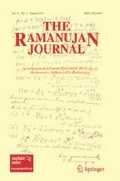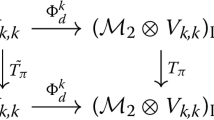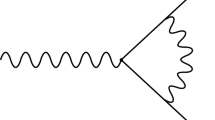Abstract
We derive a beta-integral over \({\mathbb {Z}}\times {\mathbb {R}}\), which is a counterpart of the Dougall \(_5H_5\)-formula and of the de Branges–Wilson integral, our integral includes \(_{10}H_{10}\)-summation. For a derivation we use a two-dimensional integral transform related to representations of the Lorentz group, this transform is a counterpart of the Olevskii index transform (a synonym: Jacobi transform).
Similar content being viewed by others
1 The statement
1.1 Gamma function of the complex field
Denote by \(\Lambda _{\mathbb {C}}\) the set of all pairs \(a|a'\in {\mathbb {C}}^2\) such that \(a-a'\in {\mathbb {Z}}\). For nonzero \(z\in {\mathbb {C}}\) we denote
Denote by \(\Lambda \subset \Lambda _{\mathbb {C}}\) the set of all \(a|a'\in \Lambda _{\mathbb {C}}\) satisfying the additional condition: \(a+a'\) is pure imaginary. We have
Elements of \(\Lambda \) can be represented as
Let z be a complex variable. Denote the Lebesgue measure by
Following [10], define the gamma function of the complex field by
Here \(a|a'\in \Lambda _{\mathbb {C}}\simeq {\mathbb {Z}}\times {\mathbb {C}}\). The \(\Gamma ^{\mathbb {C}}\)-function has poles at points \(a|a'=-k|-l\), where k, \(l\in {\mathbb {N}}\).
1.2 The statement
We derive the following beta-integral:
Theorem 1.1
Let \(a_1\), \(a_2\), \(a_3\), \(a_4\) satisfy the conditions \(a_\alpha >0\), \(\sum a_\alpha <1\). Then
We also can write the left-hand side as
Then the identity with the same right-hand side holds for
1.3 The de Branges–Wilson integral and the Dougall formula
Recall that the de Branges–Wilson integral is given by
This formula was obtained by de Branges [4, 5] in 1972, a proof was not published; the formula was rediscovered by Wilson [23], 1980; see also [1]. The Dougall \(_5H_5\) formula is
Setting \(b_4+\theta =1\), we get a series \(\sum _{k\geqslant 0}\) of type \(_5F_4[\dots ;1]\), this result was contained in a family of identities obtained by Dougall [8], 1906. It seems that the general bilateral formula was obtained by Bailey [3], 1936; see also [1].
Let us explain a similarity of such formulas. Denote by I(s) the integrand in (1.5) and extend it into a complex domain writing
Next, consider the sum \(\sum _{k=-\infty }^\infty I(i\theta +ik)\). We have
and we get the left-hand side of (1.6) with \(b_\alpha =1-a_\alpha \). Also, we get the same right-hand sides.
In [21] (see formula (1.28)) there was derived a one-dimensional hybrid of (1.5) and (1.6) including both integration over the real axis and a summation over a lattice on the imaginary axis.
Our integral (1.2) can be obtained by formal replacing \(\Gamma \)-factors in the integrand (1.5) by similar \(\Gamma ^{\mathbb {C}}\)-factors. The function \(\Gamma _{\mathbb {C}}\) satisfies the reflection identity
Therefore
and we come to the integrand in (1.2).
1.4 Further structure of the paper
In Sect. 2 we derive our integral (1.2). For a calculation we use a unitary integral transform \(J_{a,b}\) defined in [18], see below Sect. 2.3. This transform is an analog of a classical integral transform known under the names generalized Mehler–Fock transform, Olevskii transform, Jacobi transform, see [16, 17, 19].
We write an appropriate family of functions \(H_\mu \), and our integral (1.2) arises as the identity \(\langle J_{a,b} H_\mu , J_{a,b} H_\nu \rangle =\langle H_\mu , H_\nu \rangle \).
2 Calculation
2.1 Convergence of the integral
Lemma 2.1
Let \(a|a'\in \Lambda _{\mathbb {C}}\), \(\lambda |\lambda '\in \Lambda \), i.e., \(\lambda '=-\overline{\lambda }\). Then
In particular,
Remark
Our expression is single valued. Indeed,
But \(\lambda +\overline{\lambda }\in {\mathbb {Z}}\), and therefore the result does not depend on a choice of a branch of \(\ln \lambda \). \(\square \)
Proof
We use two expressions for \(\Gamma ^{\mathbb {C}}(a+\lambda |a'-\overline{\lambda })\), namely,
If \(|\arg \lambda |<\pi -\varepsilon \), then we apply the Stirling formula (see e.g., [1]) to the first expression. If \(|\arg (-\lambda )|<\pi -\varepsilon \), we apply it to the second expression. \(\square \)
Corollary 2.2
If the parameters \(a_\alpha \) satisfy (1.4), then the integral (1.3) absolutely converges.
2.2 The Gauss hypergeometric function of the complex field
For \(h|h'\in \Lambda _{\mathbb {C}}\) we denote
Following [10] (see also [9], Sect. II.3.7) we define the beta function \(B^{\mathbb {C}}[\cdot ]\) and the Gauss hypergeometric function  of the complex field. Let \(a|a'\), \(b|b'\in \Lambda \). Then
of the complex field. Let \(a|a'\), \(b|b'\in \Lambda \). Then
The integral absolutely converges iff
The right-hand side gives a meromorphic continuation of \(B^{\mathbb {C}}\) to the whole \(\Lambda _{\mathbb {C}}^2\simeq {\mathbb {Z}}^2\times {\mathbb {C}}^2\).
For \(a|a'\), \(b|b'\), \(c|c'\in \Lambda \) we define the hypergeometric function

The integral has an open domain of convergence on any connected component of the set of parameters \(\Lambda _{\mathbb {C}}^3\simeq {\mathbb {Z}}^3\times {\mathbb {C}}^3\), it admits a meromorphic continuation to the whole set \(\Lambda _{\mathbb {C}}^3\), see [18], Sect. 3.
The functions  admit explicit expressions in terms of sums of products of Gauss hypergeometric functions \({}_2F_1\). The standard properties of Gauss hypergeometric functions can be transformed to similar properties of functions
admit explicit expressions in terms of sums of products of Gauss hypergeometric functions \({}_2F_1\). The standard properties of Gauss hypergeometric functions can be transformed to similar properties of functions  , see [18], Sect. 3.
, see [18], Sect. 3.
Below we need the following analog of the Gauss formula for \({}_2F_1[a,b;c;1]\):

which is valid if
see [18], Proposition 3.2, the last condition coincides with a condition of continuity of  at \(z=1\).
at \(z=1\).
2.3 The index hypergeometric transform
Fix real a, b such that
Consider the measure on \({\mathbb {C}}\) given by
Let
Consider the following function on \(\Lambda \simeq {\mathbb {Z}}\times {\mathbb {R}}\):
and consider the space \(L^2_{\mathrm {even}}(\Lambda , \varkappa _{a,b})\) of even functions on \(\Lambda \) with inner product
Next, define the kernel on \({\mathbb {C}}\times \Lambda \) by

In [18] there was obtained the following statement:
The operator \(J_{a,b}\) defined by
is a unitary operator
2.4 Application of the Mellin transform
We define a Mellin transform \(\mathcal {M}\) on \({\mathbb {C}}\) as the Fourier transform on the multiplicative group \({\mathbb {C}}^\times \) of \({\mathbb {C}}\). Since \({\mathbb {C}}^\times \simeq ({\mathbb {R}}/2\pi {\mathbb {Z}})\times {\mathbb {R}}\), the Mellin transform is reduced to the usual Fourier transform and Fourier series. We have
where \(\xi |\xi '\in \Lambda _{\mathbb {C}}\). In the cases discussed below a function f on \({\mathbb {C}}{\setminus }0\) is differentiable except the point \(t=1\), where a singularity has a form \(C_1+C_2(1-t)^{h|h'}\), \([h|h']>-1\). Also in our cases the integral (2.7) absolutely converges for \(\sigma \) being in a certain strip \(A<[\xi |\xi ']<B\). Therefore the Mellin transform is holomorphic in the strip. The inversion formula is given by
the integration is taken over arbitrary line \(\mathop {\mathrm {{Re}}}\nolimits \sigma =\gamma \), where \(A<\gamma <B\). We understand the integral (which can be non-absolutely convergent) as
The inversion formula holds at points of differentiability of f, also it holds at points of singularities of the form \(C_1+C_2(1-t)^{h|h'}\) with \(\mathop {\mathrm {{Re}}}\nolimits (h+h')>-0\). In this case we can repeat the standard proof of pointwise inversion formula for the one-dimensional Fourier transform and pointwise convergence of Fourier series, see, e. g., [15], Sect. VIII.1, VIII.3; for advanced multi-dimensional versions of the Dini condition, see, e.g., [24], Sect. 9.
Convolution \(f_1*f_2\) on \({\mathbb {C}}^\times \) is defined by
As usual, we have
this identity holds in intersection of strips of holomorphy \(\mathcal {M}(f_1)\) and \(\mathcal {M}(f_2)\). We also define a function \(f^\star (t)=f(t^{-1})\). Then
So we have the following corollary of the convolution formula:
where the integration contour is contained in the intersection of domains of holomorphy of \(\mathcal {M}f_1^\star \) and \(\mathcal {M}f_2\).
Lemma 2.3
(a) Let \([q|q']<0\). Then the Mellin transform sends a function
to
it is holomorphic in the strip
(b) Assume that
Then the Mellin transform sends a function

to the function
defined in the strip
(if it is non-empty)
Proof
The statement (a) follows from the definition of \(B^{\mathbb {C}}\)-function (2.1).
(b) The function  has singularities at \(z=0\), 1, \(\infty \) with asymptotics of the form
has singularities at \(z=0\), 1, \(\infty \) with asymptotics of the form



see [18], Theorem 3.9. This gives us a strip of convergence of the Mellin transform.
We must evaluate the integral
We change an order of the integration and integrate in z:
Integrating in t we again meet a \(B^{\mathbb {C}}\)-function and after simple cancellations and an application of the reflection formula (1.7) we come to (2.9). The successive integration is valid under conditions (2.10).
We must justify the change of order of integrations. In fact, (2.14) is absolutely convergent as a double integral, i.e.,
It is a special case of integral (2.14), we integrate it successively in z and in t under the same condition as for successive integration in (2.14). \(\square \)
Lemma 2.4
Let \(\lambda |\lambda '\in \Lambda \) and
Then

Proof
We apply formula (2.8) assuming

We evaluate Mellin transforms of \(f_1\), \(f_2\) applying Lemma 2.3. In the integrand in the right-hand side of (2.8) we get a product of two factors. The first factor is
it is holomorphic in the strip
The second factor
is holomorphic in the strip
It a, b are sufficiently small, then strips (2.17) and (2.18) have a non-empty intersection and we can apply formula (2.8). Two factors \(\Gamma ^{\mathbb {C}}(a+b-\xi |a+b-\xi ')\) cancel and we get a factor independent of \(\xi \) and the integral
The integrand up to a constant factor is a Mellin transform of a function  . By the inversion formula, integral (2.16) converts to
. By the inversion formula, integral (2.16) converts to

For sufficiently small a we can apply the Gauss identity (2.3). Thus we get (2.16) for sufficiently small a, \(b>0\).
Keeping in mind (2.11)–(2.13), we can easily verify that the integral in the left-hand side of (2.16) converges for
Thus, under these conditions the left-hand side is holomorphic. The right-hand side also is holomorphic in this domain. Therefore, they coincide. \(\square \)
2.5 Proof of Theorem 1.1
Let \(a\in {\mathbb R}\). Consider a function \(H_\mu (z)\) on \({\mathbb {C}}\) given by
Lemma 2.5
(a) \(H_\mu \in L^2({\mathbb {C}}, \rho _{a,b})\) iff
(b)
The statement (a) is trivial, (b) is reduced to \(B^{\mathbb {C}}\)-function. \(\square \)
The \(J_{a,b}\)-image of \(H_\mu \) is done by Lemma 2.4. Since \(J_{a,b}\) is unitary, we have
This is Theorem 1.1, where the parameters \(a_1\), \(a_2\), \(a_3\), \(a_4\) are a, b, \(\mu \), \(\nu \). Our calculation is valid for positive reals \(a_1\), \(a_2\), \(a_3\), \(a_4\) satisfying conditions \(a_1+a+2+2a_3<1\), \(a_1+a+2+2a_4<1\). For extending the identity to the domain (1.4) we refer to Corollary (2.2) the integral (1.3) is holomorphic in the domain (1.4), the right-hand side also is holomorphic.
3 Final remarks
3.1 Barnes–Ismagilov integrals
Let \(p\leqslant q\). Let \(a_\alpha |a_\alpha '\), \(b_\alpha |b_\alpha '\in \Lambda \). Following Ismagilov [12], we define integrals of the form
By [12], Lemma 2, such integrals admit a representation of the form

where \(\gamma _j(\cdot )\) are products of \(\Gamma \)-factors and parameters of hypergeometric functions  are linear expressions in \(a_\alpha \), \(b_\beta \) and \(a'_\alpha \), \(b'_\beta \). It is reasonable to claim that integrals
are linear expressions in \(a_\alpha \), \(b_\beta \) and \(a'_\alpha \), \(b'_\beta \). It is reasonable to claim that integrals  are hypergeometric functions of the complex field.
are hypergeometric functions of the complex field.
By Lemma 2.4.b, the functions  defined by (2.2) are compatible with this definition. Ismagilov considered
defined by (2.2) are compatible with this definition. Ismagilov considered  -expressions that are counterparts of the Racah coefficients for unitary representations of the Lorentz group \({\mathrm {SL}}(2,{\mathbb {C}})\), see also [7]. Such results apparently must be regarded as analogs of expansions in Wilson polynomials.
-expressions that are counterparts of the Racah coefficients for unitary representations of the Lorentz group \({\mathrm {SL}}(2,{\mathbb {C}})\), see also [7]. Such results apparently must be regarded as analogs of expansions in Wilson polynomials.
Our theorem is an example of a hypergeometric identity for  . For a complete parallel with the de Branges–Wilson integral we would like to have the product
. For a complete parallel with the de Branges–Wilson integral we would like to have the product
with \(a_\alpha -a'_\alpha \in {\mathbb {Z}}\) instead of (1.3) with the corresponding transformation of the right-hand side. So we expect four additional integer parameters. Our calculation allows to introduce two additional discrete parameters, namely we can replace \(H_\mu \) by \((1-z)^{-a-\mu |-a-\mu '}\). However, this is not sufficient to get a full generality. Apparently, the integral transform (2.6) admits an adding of discrete parameters.
Some beta-integrals of type (1.2) with products of \(\Gamma ^{\mathbb {C}}\)-functions were obtained by Kels [13, 14], and the integral (1.2) was obtained in another way by Derkachov, Manashov, and Valinevich in [6].
3.2 A difference problem
The de Branges–Wilson integral, the Dougall formula, and our integral (1.2) are representatives of beta integrals in the sense of Askey [2]. Quite often integrands w(x) in beta integrals are weight functions for systems of hypergeometric orthogonal polynomials. In particular, orthogonal polynomials corresponding to the de Branges–Wilson integral are the Wilson polynomials, see [1, 23]. Recall that they are even eigenfunctions of the following difference operator:
where \(i^2=-1\). If an integrand w(x) of a beta integral decreases as a power function, then only finite number of moments \(\int x^n w(x)\,\mathrm{d}x\) converge; however in this case a beta integral can be a weight for a finite system of hypergeometric orthogonal polynomials (this phenomenon was firstly observed by Romanovski in [22]), the system of orthogonal polynomials related to the Dougall \(_5H_5\) formula was obtained in [19]. On the other hand, such finite systems are discrete parts of spectra of explicitly solvable Sturm–Liouville problems (see, e.g., [11, 20]).
In the case of our integral (1.2) the integrand decreases as \(|k+is|^{2\sum a_j -8}\), and we have no orthogonal polynomials. However a difference Sturm–Liouville problem can be formulated. We consider a space of meromorphic even functions \(\Phi (\lambda |\lambda ')\) on \(\Lambda _{\mathbb {C}}\), a weight on \(\Lambda \subset \Lambda _{\mathbb {C}}\) defined by the integrand (1.2), and the following commuting difference operators:
See a simpler pair of difference operators of this kind in [18]. On the other hand, see a one-dimensional operator with continuous spectrum similar to L in Groenevelt [11].
References
Andrews, G.E., Askey, R., Roy, R.: Special Functions. Cambridge University Press, Cambridge (1999)
Askey, R.: Beta Integrals and the Associated Orthogonal Polynomials. Lecture Notes in Mathematics, vol. 1395, pp. 84–121. Springer, Berlin (1989)
Bailey, W.N.: Series of hypergeometric type which are infinite in both directions. Q. J. Math. Oxf. Ser. 7, 105–115 (1936)
de Branges, L.: Gauss spaces of entire functions. J. Math. Anal. Appl. 37, 1–41 (1972)
de Branges, L.: Tensor product spaces. J. Math. Anal. Appl. 38, 109–148 (1972)
Derkachov, S.E., Manashov, A.N., Valinevich, P.A.: \(\text{SL}(2,\mathbb{C})\) Gustafson integrals. SIGMA 14, Paper No. 030 (2018)
Derkachov, S.E., Spiridonov, V.P.: On the \(6j\)-symbols for \(\text{ SL }(2,\mathbb{C})\) group. Theor. Math. Phys. 198(1), 29–47 (2019)
Dougall, J.: On Vandermonde’s theorem and more general expansions. Proc. Edinb. Math. Soc. 25, 114–132 (1906)
Gelfand, I.M., Graev, M.I., Vilenkin, N.Ya.: Generalized Functions. Integral Geometry and Representation Theory, vol. 5. Academic Press, New York. XVII (1966)
Gelfand, I.M., Graev, M.I., Retakh, V.S.: Hypergeometric functions over an arbitrary field. Russ. Math. Surv. 59(5), 831–905 (2004)
Groenevelt, W.: The Wilson function transform. Int. Math. Res. Not. 52, 2779–2817 (2003)
Ismagilov, R.S.: Racah operators for principal series of representations of the group \(\text{ SL }(2,\mathbb{C})\). Sb. Math. 198(3), 369–381 (2007)
Kels, A.P.: A new solution of the star-triangle relation. J. Phys. A 47, 055203 (2014)
Kels, A.P.: New solutions of the star-triangle relation with discrete and continuous spin variables. J. Phys. A 48(43), 435201, 19 (2015)
Kolmogorov, A.N., Fomin, S.V.: Elements of function theory and functional analysis. (Russian) Moscow, Nauka, 1974; German transl.: VEB Deutscher Verlag der Wissenschaften, Berlin (1975)
Koornwinder, T.H.: A new proof of a Paley–Wiener theorem for the Jacobi transform. Ark. Mat. 13, 145–159 (1975)
Koornwinder, T.H.: Special Orthogonal Polynomial Systems Mapped onto Each Other by the Fourier-Jacobi Transform. Lecture Notes in Mathematics, vol. 1171, pp. 174–183. Springer, Berlin (1985)
Molchanov, V.F., Neretin, Yu.A.: A pair of commuting hypergeometric operators on the complex plane and bispectrality. J. Spectr. Theory (to appear)
Neretin, YuA: Beta-integrals and finite orthogonal systems of Wilson polynomials. Sb. Math. 193(7), 1071–1089 (2002)
Neretin, YuA: Some continuous analogs of expansion in Jacobi polynomials and vector valued hypergeometric orthogonal bases. Funct. Anal. Appl. 39(2), 106–119 (2005)
Neretin, YuA: Perturbations of Jacobi polynomials and piecewise hypergeometric orthogonal systems. Sb. Math. 197(11), 1607–1633 (2006)
Romanovski, V.: Sur quelques classes nouvelles de polynómes orthogonaux. C. R. Acad. Sci. Paris 188, 1023–1025 (1929)
Wilson, J.A.: Some hypergeometric orthogonal polynomials. SIAM J. Math. Anal. 11(4), 690–701 (1980)
Zhizhiashvili, L.V.: Some problems in the theory of simple and multiple trigonometric and orthogonal series. Russ. Math. Surv. 28(2), 65–127 (1973)
Acknowledgements
Open access funding provided by Austrian Science Fund (FWF).
Author information
Authors and Affiliations
Corresponding author
Additional information
Publisher's Note
Springer Nature remains neutral with regard to jurisdictional claims in published maps and institutional affiliations.
Supported by the grants FWF, P28421, P31591.
Rights and permissions
Open Access This article is distributed under the terms of the Creative Commons Attribution 4.0 International License (http://creativecommons.org/licenses/by/4.0/), which permits unrestricted use, distribution, and reproduction in any medium, provided you give appropriate credit to the original author(s) and the source, provide a link to the Creative Commons license, and indicate if changes were made.
About this article
Cite this article
Neretin, Y.A. An analog of the Dougall formula and of the de Branges–Wilson integral. Ramanujan J 54, 93–106 (2021). https://doi.org/10.1007/s11139-019-00218-0
Received:
Accepted:
Published:
Issue Date:
DOI: https://doi.org/10.1007/s11139-019-00218-0




